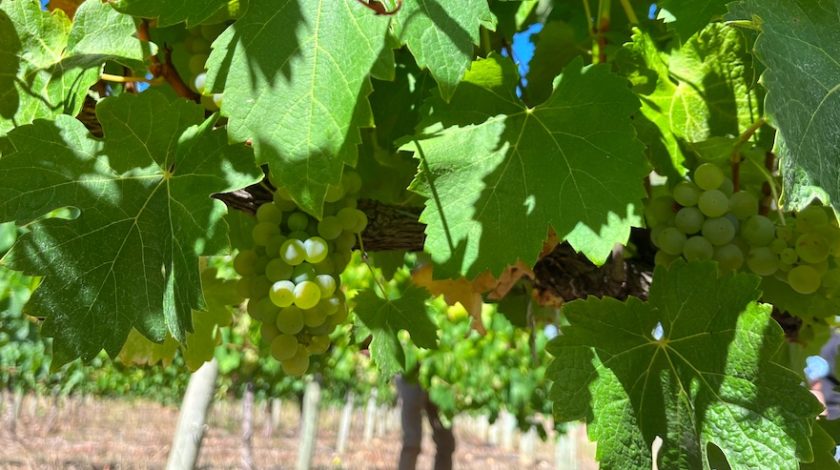There’s nothing like gaining some hands on experience and I had the opportunity to help Alkina with vintage ’22. Apparently, it’s been a relatively ‘cool’ summer here in the Southern hemisphere which has meant harvest started pretty late this year and in true mother nature style it also meant everything happened at once. So it really was all hands to the pump to help get the grapes in, sorted, crushed and into the fermentation tanks.
So how do you decide when it’s just the right time to start picking? It’s a combination of a number of factors determined by the type and style of wine to be made: winemakers are trying to juggle sugar and acid content, aroma and flavour profiles as well as tannin and colour development. But most importantly it really has to do with sugar. The sugar in the grapes is converted to alcohol by yeast during the fermentation process and it’s essential the sugar levels are at a certain point before picking. Typically sugar levels in grapes are measured by degrees baumé, which is a fancy measurement made by a hydrometer, but helpfully the actual degrees baumé measurement converts directly to alcohol level so 13 degrees baumé in your grapes = 13% alcohol in your finished wine. Other considerations determined by wine style mean that whites tend to be picked before reds and lighter styles earlier than fuller bodied. If you’re around a vineyard nearing harvest you’ll see the winemakers out there measuring and tasting the grapes daily to judge just when it’s right. And of course mother nature can play a role: heavy rain due…you’ll likely want to get those grapes off the vines to prevent the rain diluting them.
So the magical day arrived and the picking team were in full swing. Alkina hand harvest the majority of their grapes as it enables the team to be more selective on the best bunches, avoiding any that are under or over-ripe or showing any sign of disease, and it means they can whole-bunch ferment…advantages explained below! While picking the grapes on a 30 degree day sounded like a much better gig than my last experience in the UK (I was wet to the bone by the end of the day!)…the snake and spider briefing was certainly enough to scare me back to the winery. Hats off to the incredible team that work methodically through the vineyard, harvesting around 8-10 tonnes by hand a day.




Once the grapes are picked they are transported back to the winery, placed on a sorting table where a motorised, moving, vibrating belt gradually transports the bunches and we sorters sift through them picking out anything and everything you do not want in your wine…vine leaves, twigs, snails, spiders(!) and many many earwigs. Importantly we’re also looking for any grape bunches that are under or over-ripe that will impact the flavour of the final wine: under-ripe = acidic and astringent/ over-ripe = jammy/ raisiny. Once the grapes are sorted the belt drops them into fermentation tanks where they are crushed, by (wo/)man or machine, to release the juice.
Alkina’s quest is to make minimal intervention wines, they see themselves as caretakers and really aim to translate what is in the vineyard into the glass. So that means in practice not too much mechanisation, plenty of hands-on tasks and some traditional techniques. Whole-bunch winemaking is the original way of making wine, and means fermenting the grapes with their stalks and all. Today most are de-stemmed but whole-bunch is making a resurgence and is a technique often used by premium Burgundy producers. Alkina choose to whole-bunch ferment some of their wines because they are aiming for freshness and added personality in the wines, which the stems help to achieve. Plus there’s nothing quite like squishing those grapes between your toes…
Once in tank the fascinating process of fermentation can kick off. Typically winemakers will choose to add a particular type of yeast to kick off the fermentation process as the commercial yeast strains have greater reliability and are easier to control. However, natural yeasts found in the vineyard, in the winery and on the grape skins will kick the process off themselves if left to their own devices. Again this natural technique is having a resurgence, it is often referred to as ‘wild ferment’.
The fermentation process takes anywhere from 7 – 21 days for white wines and 5 – 10 days for reds. This is due to the temperature differences as white wine ferments at around 12-15°C while reds ferment at 20-35°C, higher temperature means faster process. Winemakers monitor this process every day to check for off-flavours, to monitor the temperature and sugar levels and to mix the ferment. Fermentation is an exothermic process so it produces heat, too much heat will kill the yeast and stop them doing their important job…producing the alcohol! The fermentation process is finished when the yeast have done their job of eating all the sugar (if producing a dry wine), they will then die and settle at the bottom of the tank. So until then GO YEAST, GO!


More to come on what happens post ferment soon!



Great blog Ellie….. looking forward to the next instalment.